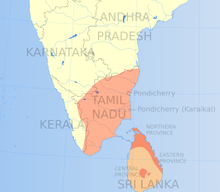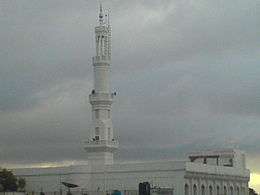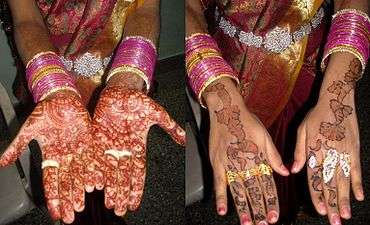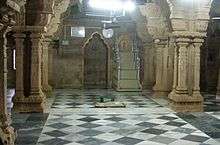Tamil Muslim
| Regions with significant populations | |
|---|---|
| Religion | |
| Islam | |
| Related ethnic groups | |
| Tamil people |
| Part of a series on |
| Tamils |
|---|
 |
Tamil Muslims are Tamils who practise Islam. The community exists primarily in the Indian state of Tamil Nadu. Tamil-speaking Muslims in Sri Lanka are classified as Moors (not Tamils) due to independent lineage.[1][2][3]
The community is predominantly urban. There is a substantial diaspora, particularly in South East Asia, which has seen their presence as early as the 13th century. In the late 20th century, the diaspora expanded to North America and Western Europe.[4]
Ethnic identity

Though numerically nominal, the community is not homogeneous. Its origin is shaped by miscegenation and centuries of trade between the Bay of Bengal and the Maritime Southeast Asia. By the 20th century, certain Tamil communities began to be listed as social classes in official gazettes of different nations as Marakayar, Rowther and Lebbai.[5][6][7][8]
Economy
In Tamil Nadu, the community is well known as rentiers, entrepreneurs, gemstone jewellers and money changers with above State-average GDP per capita incomes.[9]
Marakkayar
Claiming Arabic descent, the Marakayar sect has played a large role in the educational and economic landscape in Tamil Nadu since the 17th century. One notable sea-faring merchant, as recorded in the Chronicles of Thondaiman, was Periya Thambi Nainar Marakkayar who is widely believed to be the first rupee millionaire in the community. His son Seethakaathi, an altruist, commissioned the penning of Seerapuranam by Umaru Pulavar. By the 20th century, B. S. Abdur Rahman had emerged as the first dollar billionaire.[10][11]
Culture

Legends and rituals
As a mark of modesty, women usually wear white thuppatti (whilst travelling only) which is draped over their body on top of the saree but revealing face. Many visit (Dargah) on major life milestones like births, marriages and deaths.[12]

Literature
The earliest Tamil Muslim literary works could be traced to the 14th century in the form of Palsanthmalai, a small work of eight stanzas. In 1572, Seyku Issaku, better known as Vanna Parimala Pulavar, published Aayira Masala Venru Vazhankum Adisaya Puranam detailing the Islamic principles and beliefs in a FAQ format. In 1592, Aali Pulavar wrote the Mikurasu Malai. The epic Seerapuranam by Umaru Pulavar is dated to the 17th century[13] and still considered as the crowning achievement of Tamil Muslim literature. Other significant works of 17th century include Thiruneri Neetham by Sufi master Pir Mohammad, Kanakabhisheka Malai by Seyku Nainar Khan (alias Kanakavirayar), Tirumana Katchi by Sekathi Nainan and the Iraq war ballad Sackoon Pataippor.[14]
Nevertheless, an independent identity evolved only in the last quarter of the 20th century triggered by the rise of Dravidian politics as well as the introduction of new mass communications and lithographic technologies.[15][16] The world's first Tamil Islamic Literature Conference was held in Trichy in 1973. In early 2000. the Department of Tamil Islamic Literature was set up in the University of Madras.[17] Modern notable writers include Mu Metha and Pavalar Inqulab,[18]
Law and polity
Pre-independence
P. Kalifulla served as the minister for public works in the Cabinet of Kurma Venkata Reddy Naidu in 1937. He was sympathetic to the cause of Periyar E. V. Ramasamy and his Self-Respect Movement. He spoke against the introduction of compulsory Hindi classes in the Madras legislature and participated in the anti-Hindi agitations. He was a lawyer by profession and was known by the honorifics Khan Bahadur. He became the Dewan of Pudukottai after withdrawal from political work.
Sir Mohammad Usman was the most prominent among the early political leaders of the community. In 1930, Jamal Mohammad became the president of the Madras Presidency Muslim League.[19] Until then, the party was dominated by Urdu speakers. Yakub Hasan Sait served as a minister in the Rajaji administration. Allama Karim Gani, veteran freedom fighter and a close associate of Subash Chandra Bose, who hailed from Ilayangudi, served as Information Minister in Netaji ministry during the 1930s.
Post-independence
Since the late 20th century, politicians like Quaid-e-Millat (first President of Indian Union Muslim League) and Dawood Shah advocated Tamil to be made an official language of India due to its antiquity in parliamentary debates[20]
The community was united in a single political party under Quaid-e-Millath presidency for 27 years keeping rabble-rousers away until his death in 1972. Their support was invaluable for ruling parties in the state, as well as in the Centre. He was instrumental in framing and obtaining the minority status and privileges for minorities in India thus safeguarding the Constitution of India. His newspaper Urimaikkural was a very popular daily.
M. M. Ismail became Chief Justice in 1979 and was sworn in as Acting Governor of Tamil Nadu in 1980. As Kamban Kazhagam president, he organised literary festivals, that focussed on classical Tamil literature. Justice S. A. Kader who was the Judge of Madras High Court during 1983-89 became the President of Tamil Nadu State Government Consumer Disputes Redressal Commission on retirement.[21]
In the early 1990s, the Indian National League split from the IUML.[22] The non-denominational social reform movements (called Ghair Muqallid) began to take the front stage (supposedly to fight superstition creep) spearheaded by P. Jainulabdeen further weakening the IUML and causing unrest among community elders who preferred status quo and conservatism. Nevertheless, the Tamil Nadu Muslim Munnetra Kazagham was constituted in 1995. This non-profit organisation quickly became popular and assertive among the working class youth. Later, the Manithaneya Makkal Katchi, the political arm of TMMK was formed. But TMMK itself split to form the break-away organisation Tamil Nadu Thowheed Jamath soon. MMK contested in three seats and won two Assembly seats viz. Ambur (A. Aslam Basha) and Ramanathapuram (M. H. Jawahirullah).
Broadly speaking, the community vote bank tends to support laissez faire and free trade; and have been unimpressed by Communism as a public policy though fringe working class factions often called for affirmative action in the last quarter of the 20th century.[23]
21st century
New generation of leaders like Daud Sharifa Khanum have been active in pioneering social reforms like independent mosques for women.[24][25]
MLAs and MPs such as A. Anwar Rhazza, J. M. Aaroon Rashid, Abdul Rahman, Jinna, Khaleelur Rahman, S. N. M. Ubayadullah, Hassan Ali and T. P. M. Mohideen Khan are found across all major Dravidian political parties like DMK, DMDK and AIADMK, as well as national parties like the INC.
At the age of 30, the award-winning documentarian Aloor Shanavas became the Deputy General Secretary of Viduthalai Chiruthaigal Katchi.[26]
References
- ↑ Mines, Mattison (1978). "Social stratification among the Muslims in Tamil Nadu, South India". In Ahamed, Imtiaz. Caste and Social Stratification Among Muslims in India. Manohar.
- ↑ Muslim Merchants – The Economic Behaviours of the Indian Muslim Community, Shri Ram Centre for Industrial Relations and Human Resources, New Delhi, 1972
- ↑ de Silva, C.R. Sri Lanka — A History, pp. 3–5, 9
- ↑ Sayeed, A. R. (1977). "Indian Muslims and some Problems of Modernisation". In Srinivas, M. N. Dimensions of Social Change in India. p. 217.
- ↑ Tamil Muslims dominate restaurant industry in Malaysia Archived 2010-02-15 at the Wayback Machine.
- ↑ Appadurai, Arjun (1977). "Kings, Sects and Temples in South India, 1350-1700 A.D". The Indian Economic & Social History Review. XIV (1).
- ↑ Hiltebeitel, A (1999) Rethinking India's oral and classical epics. p. 376 (11). University of Chicago Press. ISBN 0-226-34050-3
- ↑ Zafar Anjum, Indians Roar In The Lion City. littleindia.com
- ↑ Tyabji, Amina (1991). "Minority Muslim Businesses in Singapore". In Ariff, Mohamed. The Muslim Private Sector in Southeast Asia: Islam and the Economic Development of Southeast Asia. Institute of Southeast Asian Studies. p. 60. ISBN 978-9-81301-609-5.
- ↑ S. Arunachalam, The History of Pearl Fishery of Tamil Coast, Annamalai Nagar 1952, p. 11
- ↑ Sanjay Subramanian, The Political Economy of Commerce, Southern India 1500 – 1650, New York 1990
- ↑ Stephen F' Dale Recent Researches on the Islamic Communities of Peninsular India, Studies in South India, ed. Robert E. Frykenbers and Paulin Kolenda (Madras 1985)
- ↑ The Diversity in Indian Islam. International.ucla.edu. Retrieved on 2012-06-27.
- ↑ N. A. Ameer Ali, Vallal Seethakkathiyin Vaazhvum Kaalamum, Madras 1983, p. 30-31, Ka. Mu. Sheriff, Vallal Seethakkathi Varalaru, 1986, pp. 60–62, M. Idris Marakkayar, Nanilam Potrum Nannagar Keelakkarai, 1990
- ↑ Tamil Muslim identity. Hindu.com (2004-10-12). Retrieved on 2012-06-27.
- ↑ J.B.P.More (1 January 2004). Muslim Identity, Print Culture, and the Dravidian Factor in Tamil Nadu. Orient Blackswan. pp. 1–. ISBN 978-81-250-2632-7. Retrieved 27 June 2012.
- ↑ Islamic Voice (magazine)
- ↑ Irandaam Jaamangalin Kathai. Hindu.com. Retrieved on 2012-06-27.
- ↑ J.B.P.More (1 January 1997). Political Evolution of Muslims in Tamilnadu and Madras 1930–1947. Orient Blackswan. pp. 116–. ISBN 978-81-250-1192-7. Retrieved 27 June 2012.
- ↑ Tamil Muslim Periyar Thatstamil.oneindia.in. Retrieved on 2012-06-27
- ↑ http://www.supremecourtofindia.nic.in/circular/senioradvocates.pdf
- ↑ Tamil Nadu / Chennai News : Indian National League State unit dissolved. The Hindu (2011-01-21). Retrieved on 2012-06-27.
- ↑ Susan Bayly, Saints, Goddesses and Kings — Muslims and Christians in South Indian Society, Cambridge, 1989
- ↑ Biswas, Soutik. (2004-01-27) World's first Masjid for Women. BBC News. Retrieved on 2012-06-27.
- ↑ Pandey, Geeta. (2005-08-19) World | South Asia | Women battle on with mosque plan. BBC News. Retrieved on 2012-06-27.
- ↑ "Aloor Shanavas at age 30".
Further reading
- Sinnappa Arasaratnam, Merchants, Companies and Commerce on the Coromandel Coast 1650 – 1740, New Delhi 1986
- Maritime India in the Seventeenth Century, New Delhi 1994
- Maritime Commerce and English Power (South East India), 1750 – 1800, New Delhi 1996
- Dutch East Indian Company and the Kingdom of Madura, 1650 – 1700, Tamil Culture, Vol. 1, 1963, pp. 48–74
- A Note on Periyathambi Marakkayar, 17th century Commercial Magnate, Tamil Culture, Vol. 10, No. 1, 1964, pp. 1–7
- Indian Merchants and the Decline of Indian Mercantile Activity, the Coromandel case, The Calcutta Historical Journal, Vol. VII, No. 2/1983, pp. 27–43
- Commerce, Merchants and Entrepreneurship in Tamil Country in 18th century, paper presented in the 8th World Tamil Conference seminar, Thanjavur, 1995
External links
- TNTJ demands 10 percentage reservation for muslims. The Hindu (2010-06-13). Retrieved on 2012-06-27.